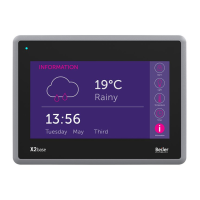5. Chemical Resistance
5.1. Touch Screen and Overlay Material
5.1.1. Protective Film
The Autoflex protective film covers the overlay surrounding the screen.
Solvent Resistance
The protective film withstands exposure of more than 24 hours duration under DIN 42115 Part 2 to
the following chemicals without visible change:
Acetonitrile Diesel Petroleum spirit
1
Ajax / Vim in solution Downy / Lenor
1
Phosphoric acid (<30%)
Alkalicarbonate solution
1
Ethanol Potassium ferricyanide
Ammonia (<40%)
1
Glycerine Potassium hydroxide (<30%)
Acetic acid (<50%) Glycol Pure Turpentine
Ariel powder in solution
1
Gumption
1
SBP 60/95
1
Bleach
1
Hydrochloric acid (<36%) Sulfuric acid (<10%)
Castor oil Linseed oil Tomato ketchup
Caustic soda (<40%)
1
Methanol Trichloroacetic acid (<50%)
Cutting oil Nitric acid (<10%) White Spirit
Cyclohexanol Paraffin oil Windex
1
Diacetone alcohol Persil powder in solution
1
Wisk
1
Extremely faint glossing of the texture was noted.
The Autoflex protective film withstands DIN 42 115 Part 2 exposure of up to 1 hour duration to glacial
acetic acid without visible change.
The Autoflex protective film is not resistant to high pressure steam at over 100°C or the following
chemicals:
Concentrated mineral acids Benzyl alcohol
Concentrated caustic solution Methylene chloride
5.1.2. Touch Screen Surface
The touch screen surface on the HMI panel withstands exposure to the following solvents without
visible change:
Solvents Time
Acetone 10 minutes
Isopropanol 10 minutes
Toluene 5 hours
The touch screen surface on the HMI panel is made of polyester with a hard coat to resist scratches
and withstand exposure to many solvents without visible change.
Chemical Resistance
2023-09 16 Beijer Electronics, MAEN330

